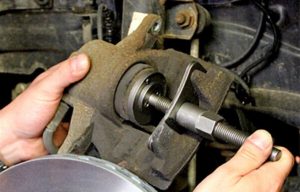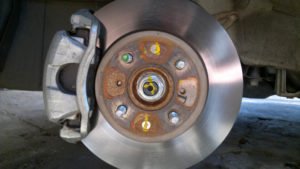How to Fix a Seized Brake Caliper
How Can I Tell If My Brake Caliper is Seized and Needs to be Fixed?
You could experience the issues of a seized brake caliper if:
- Your vehicle was not used for a long time – This is the easiest to diagnose because when you try to drive it feel like the brakes are on or even worse, the car won’t move at all.
- Your caliper slide pins have seized – Everything appears to be normal but the pads will be pushed onto the disc from the piston side continuously. This reduces braking ability on that wheel and prematurely wears the pad. Oddly enough… your car might pull to the opposite side when you apply the brakes.
- Your piston is stuck within the caliper or the pad is stuck – You will feel your car down on power, similar to when the parking brake is on. Also you might feel your car pulling to one side constantly at any speed.
- You brakes on one wheel will bind – Gradually you may not notice any difference until your state’s yearly safety inspection when you fail the straight stop test. Not all states conduct this particular test however. Even without this inspection, you my notice your vehicle pulling to one side even after an alignment.
- The handbrake cable or mechanism is hung up – This happens because of the lack of lubrication. The wire/cable can’t travel as it should when the handbrake/foot brake is released and it results in the brakes remaining on.
What Can Happen If My Brakes Seize While Driving?
A seized brake caliper might not seem like much but while driving, however… it might get very hot. At one point you will experience a burning smell or see smoke coming from one of the wheels. This is what happens when the brakes are overheating. At this point it would be best to stop before you catch some existing grease or oil on fire. If you continue to drive it can generate enough heat to possibly start a fire. Even if it does not generate a fire, you’ll surely damage the brake caliper/disc and any other components connected to the wheel hub.
What Causes This Issue?

In short: “CORROSION”.
This appears often if the vehicle is left unmoved for months especially parked outside. Rust can appear on the discs, pads, caliper pistons or caliper sliders and will prohibit the system from operating as it should.
Being subject to huge temperature ranges, humidity, salt spray and other nasty elements… while rarely serviced or inspected, brakes can load up on some serious corrosion conditions in key areas. This can cause a seized brake caliper along with other brake component failures.
What Is The Remedy To a Brake Caliper that Seized ?
Depending on the issues you are confronting, there are 2 ways to go about it:
- If the issue appears because of a skewed pad, or brake pads sticking to the rotor/disc or a parking brake mechanism/cable failure, then you’re in luck. Your system just needs maintenance and a dose of cleaning along with the proper brake lubrication to operate again. You must lubricate the parking brake system or remove the brake pads, slides, and apply a small amount of grease to the edges to fix the skewed pads/slides. Also inspect all components including pistons and seals to assure they are not hung up in the caliper/piston bore. However, the best way to fix pads that are stuck to the disc is to resurface the rotor/disc and replace the brake pads along with other components. You can also purchase remanufactured brake calipers.

- If the issue appears because of a seized caliper piston or slide pin then you will need a special tool to retract the pad.
Don’t have such a tool? Thankfully often a simple c-clamp will get you going. Another way to remove the caliper piston is to use the brake system’s hydraulic pressure. Just remove the caliper from the disc and pump the brake pedal to move the piston past the corroded area. After this step it’s easier to disassemble and rebuild. Once again, you could go to your nearest auto parts store and request a rebuilt or new brake caliper assembly.
Should I Replace It Or Rebuild?
Caliper pistons or slide pins tend to seize again even after being cleaned. The corrosion that made the unit stick in the first place, will still be there. It will just take some time until it will stick again. The key is checking the brake system internals for corrosion. If it’s ugly, the only way to repair is by replacing these components. After all, we’re talking about your brakes here… the most important function of your vehicle. If it’s not too badly damaged, then a rebuild might be cheaper. The only special tool you would need is a brake hone to clean the caliper’s internal bore and some new seals and maybe a piston also. Rebuilding can be done at home and it involves disassembly, cleaning plus replacing rubber parts and any other components required. If this isn’t your cup of tea, take your vehicle to your nearest mechanic.
Can All Of This Be Avoided?
Oftentimes even though the braking system is the most important part of our daily commute it get’s the least attention. These issues above can be indeed avoided by checking the system for rust build up more often. Also checking the pads/rotors to see if there’s any uneven or premature wear and most importantly lubricate the system.
Caliper pistons, slide pins and edge of the pads can be protected by applying a high temp grease on them. This would provide the much needed lubrication and allow protection from the outside forces to prevent rust from appearing. One such grease that can be used is CleanBoost® Mettle Plus EP2 High Temp Grease . It has a superior lithium complex formula designed to provide excellent lubricating qualities over a wide range of temperatures. It’s designed for work under the toughest conditions and not brush off even if
Did not move the car for a while?
If you did not move your car for a whileand didn’t get a chance to apply grease to the components, before you move your car it would be best to CAREFULLY spray some CleanBoost® Nano-Spray™ on the caliper pistons, slide pins and contacts. Avoid the pads themselves however. It will penetrate the rust and lubricate the components weakening any rust spots and increasing the chances for your brakes to run smoothly. Once again, preventive maintenance always is your best bet with brake systems as this will most likely always prevent a seized brake caliper.
If you would like to dive more in-depth into all the parts that make up the brakes of your car, we invite you to read this article over here from RainbowMuffler
About the Author
Tech Guy
Automotive enthusiast, passionate about Jeeps, hot-rods, turbos, performance, efficiency, diesels, fuels, high performance oils, additives and anything with an engine.

